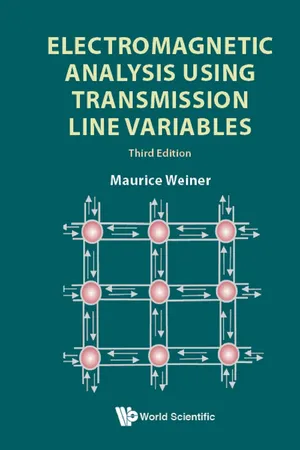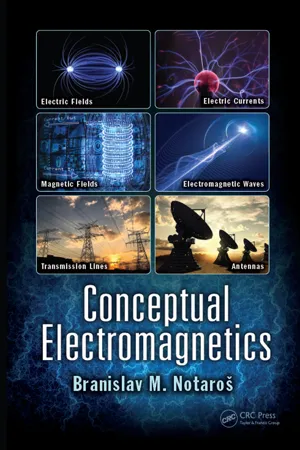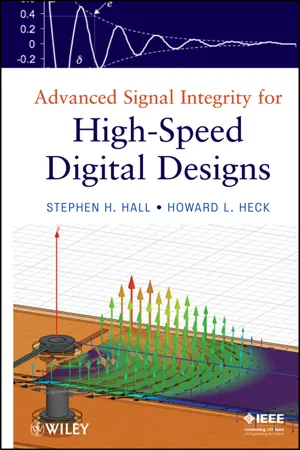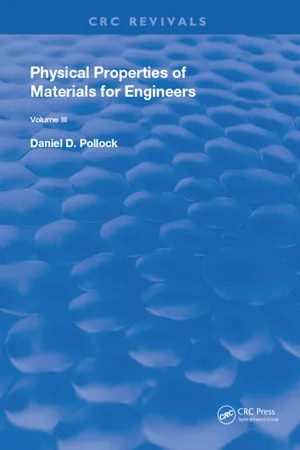Physics
Dielectric Boundary Conditions
Dielectric boundary conditions refer to the rules that govern the behavior of electric fields at the interface between different dielectric materials. These conditions dictate how the electric field and its normal component change across the boundary. They are crucial for understanding the behavior of electric fields in materials and devices such as capacitors and waveguides.
Written by Perlego with AI-assistance
Related key terms
Related key terms
1 of 4
Related key terms
1 of 3
7 Key excerpts on "Dielectric Boundary Conditions"
- Maurice Weiner(Author)
- 2017(Publication Date)
- WSPC(Publisher)
In the following we discuss several kinds of boundary conditions one is likely to encounter in the TLM analysis. The two most common boundary conditions are the dielectric-dielectric and dielectric-conductor interfaces. It is difficult to imagine an electromagnetic configuration without the presence of one or the other of these two interfaces. However other kinds of boundaries are possible. For simulation purposes the idealized dielectric-infinite permeability interface, or “open circuit”, provides a convenient means for obtaining total reflection of the wave energy from a given surface The open circuit is often useful since it may be used to approximate experimental conditions in which the radiated wave energy at a given surface is small, due to a very large mismatch in impedance levels. A conducting surface also will provide total reflection but with a resultant field inversion.Other boundary conditions relate to the input/output of the electromagnetic signal. Here we specify the conditions under which electromagnetic energy is introduced into or leaves the region of interest, whether it be a closed device or an antenna. The difference between the input and output energies results in either the dissipation or storage of energy in the region of interest. In the following we describe ways in which to simulate the boundary conditions, using the TLM cell matrix and appropriate values of node resistors and transmission line impedances. Only symmetric variables are used but this does not alter the discussion in any significant way.5.1Dielectric-Dielectric InterfaceThere are several choices for positioning the TLM boundary of a dielectric-dielectric interface, two of which are shown in Fig. 5.1 . The side view shows the dielectric - dielectric interface with constants ε1 and ε2 . The permeability μ is assumed to be the same in both regions. In contrast, we assume ε1 > ε2 . The propagation velocities in each region satisfywhere v1 and v2 are the velocities in regions 1 and 2 respectively. If we wish to retain the same time step in each region, Δt, then we are forced to adopt different cell sizes in each region. Since the linear dimension of each cell is proportional to the velocity, the transmission line lengths in each region, Δl1 and Δl2- eBook - ePub
- Branislav M. Notaroš(Author)
- 2017(Publication Date)
- CRC Press(Publisher)
ELECTROSTATIC FIELD IN DIELECTRICS IntroductionDielectrics or insulators are nonconducting materials, having very little free charges inside them (theoretically, perfect dielectrics have no free charges). However, another type of charge, called bound or polarization charges, exist in a polarized dielectric, as atoms and molecules in the dielectric behave like microscopic electric dipoles. In electrostatic systems containing both conductors and dielectrics, the equivalent electric-field sources are both free and bound charges, considered to reside in free space. By introducing the concept of dielectric permittivity, we are left, in turn, to deal with free charges in the system only, while the contribution of bound charges to the field is properly added through the permittivity. In continuation, we analyze capacitors and transmission lines, composed of both conductors and dielectrics, to evaluate and discuss their capacitance, energy, and breakdown characteristics, as a culmination of our study of the theory and applications of the electrostatic field.2.1 Polarization of DielectricsEach atom or molecule in a dielectric is electrically neutral. For most dielectrics, centers of “gravity” of the positive and negative charges in an atom or molecule coincide – in the absence of the external electric field. When a dielectric is placed in an external field, of intensity E, however, the positive and negative charges shift in opposite directions against their mutual attraction, and produce a small electric dipole. The moment of this equivalent dipole is given by p = Qd, where Q is the positive charge of the atom or molecule (−Q is the negative charge), and d is the vector displacement of Q with respect to −Q. The charges are displaced from their equilibrium positions by forces [Eq. (1.3) ] Fe1 = QE and Fe2 = −QE, respectively. The displacement d is very small, on the order of the dimensions of atoms and molecules. The charges Q and −Q are bound in place by atomic and molecular forces and can only shift positions slightly in response to the external field. So, the two charges in an equivalent small dipole cannot separate one from the other and migrate across the material in opposite directions run by the electric field. Hence, these charges are called bound charges (in contrast to free charges). Some dielectrics, such as water, have molecules with a permanent displacement between the centers of the positive and negative charge, so that they act as small electric dipoles even with no applied electric field. According to Figure 2.1 , the torques (moments) of forces Fe1 and Fe2 with respect to the center of the dipole (point O) are T1 = r1 × Fe1 and T2 = r2 × Fe2 , with r1 and r2 denoting the position vectors of Q and −Q with respect to the dipole center. We notice that r1 − r2 = d - Stephen H. Hall, Howard L. Heck(Authors)
- 2011(Publication Date)
- Wiley-IEEE Press(Publisher)
As the speed of digital systems continues to increase with Moore’s law, the electrical performance of the dielectric layers of the printed circuit board, package, or multichip modules becomes significantly more important. Dielectric materials that worked perfectly well for slower designs become increasingly difficult to design with because new phenomena, such as frequency–dependent dielectric permittivity and loss tangents, environmental factors, and localized interactions between the electromagnetic signal and the fiber weave reinforcement of the board, become significant and can no longer be ignored. Without properly accounting for the high–speed dielectric phenomena, it becomes impossible to properly predict phase delay and signal losses, leading to nonphysical behavior of the transmission line model. In short, simulation–based digital bus designs exceeding 3 to 5 GHz are not possible without accounting for the effects covered in this chapter.Dielectrics , more commonly called insulators , are substances whose charges in the molecules and atoms are bound and therefore cannot move over macroscopic distances under the influence of an applied field. Ideal dielectrics do not contain any free charge (such as in conductors), and chemical structure is macroscopically neutral. When a field is applied to a dielectric, the bound charges do not move to the surface of the material as they would in a conductor, but the electron clouds associated with the atomic and molecular structures of the dielectric can be distorted, reoriented, or displaced, inducing electric dipoles. When this happens, the dielectric is said to be polarized . The polarizability of a dielectric leads directly to the definition of the relative permittivity, dielectric losses, and the relationship between energy propagation and losses.6.1 POLARIZATION OF DIELECTRICSFor a metal, conductivity is caused by the redistribution of free charges over a macroscopic distance. For example, Figure 5-4- eBook - ePub
Materials Under Extreme Conditions
Recent Trends and Future Prospects
- A.K. Tyagi, S. Banerjee, A. K. Tyagi(Authors)
- 2017(Publication Date)
- Elsevier(Publisher)
In general, on application of electric field at the two opposite ends of dielectric material, the opposite charges are displaced, thus creating dipoles inside the bulk matrix of it. This is measured as the extent of polarization, which is defined as net dipole moments per unit volume (P = ∑ μ i / V). The polarization in a dielectric material can be of different origins, like electronic, ionic, dipolar, and interfacial polarization (Fig. 22.7), which are activated at different frequencies of alternating electric or electromagnetic field. Electronic polarization occurs due to displacement of the center of negatively charged electron cloud relative to the positive nucleus of atom by the electric field. Ionic polarization occurs in ionic materials. In an ionic lattice, the positive ions are displaced in the direction of applied electric field, whereas negative ions get displaced in the opposite direction to the applied electric field, giving rise to net dipole moment. If the molecules possess permanent dipole moments, the rotation of these dipoles under an electric field will produce the dipolar polarization. Therefore, the dipolar polarization is strongly dependent on the frequency of the applied electric field and on the temperature. By the application of low-frequency field some of these bound charge carriers migrate over a distance. The translating charge carriers are accelerated by an applied field until they are opposed by or trapped at the physical barriers in these heterogeneous systems. This buildup of charges causes the polarization of the material. Space charge or interfacial polarization occurs in heterogeneous systems such as multicomponent materials or incompatible chemical substance-containing materials. Space charge polarization is the governing factor of dielectric properties at lower frequency. Electronic, ionic, and orientation polarization arises when charges are locally bound in atoms, molecules, or structures of solids or liquids - eBook - ePub
- Anupam Garg(Author)
- 2012(Publication Date)
- Princeton University Press(Publisher)
15 Electrostatics of dielectrics94 The dielectric constant
Nonconducting materials, also known as insulators or dielectrics, differ from conductors in that (i) any free (mobile) charge must be externally supplied, and (ii) electric fields can penetrate inside them. For electrostatics, the macroscopic equations to be solved are Gauss’s lawand the law that the electric field is irrotational,As discussed in chapter 13 , to solve eqs. (94.1) and (94.2) one needs a constitutive relation connecting D and E , or, equivalently, a knowledge of P. 1 For most materials, it is found that D is linear in E , at least for low enough electric fields. The reason is exactly the same as that behind the concept of polarizability (section 89): at low fields, the induced dipole moments are linear in E , so P is linear in E. For isotropic materials, we write2The quantity (in Gaussian units), or / 0 (in SI), is known as the dielectric constant of the material.3 It is a dimensionless number with the same value in both systems. For anisotropic systems, such as solid or liquid crystals, a linear relationship must, in general, be tensorial:where ij are the components of the dielectric tensor. In the special case of cubic crystals, the tensor is isotropic, ij =δij, so one is back to eq. (94.3). Hence, such crystals behave like isotropic materials in their dielectric properties.At the risk of being tiresome, we repeat that while eq. (94.3) is valid for a large variety of matter, it is not a fundamental law. Also, it holds only if the field E is small enough. We gave examples of the range of validity in chapter 13 - eBook - ePub
- Michael M. Mansfield, Colm O'Sullivan(Authors)
- 2020(Publication Date)
- Wiley(Publisher)
Experimentally, for most dielectric materials, it is found that | E pol | is directly proportional to | E | over a reasonably wide range of field strength values, that is The constant of proportionality χ e is called the electric susceptibility and is characteristic of the material involved. Note that, since P = − ε 0 E pol, the electric polarization is Thus, using Equation (17.3), the electric field strength at a point within a dielectric material is given by Hence and we can now interpret the permittivity of the medium to be Values of permittivity are often given in terms of relative permittivity, the value of the permittivity relative to that of vacuum, that is For most dielectric materials in typical electric fields, therefore, a plot of D versus E (or P versus E) yields a straight line (Figure 17.7). Such substances are described as linear materials. Figure 17.7 Plot of polarization versus electric field strength for a linear material. The slope of the straight line is ε 0 χ e. In the discussion above it has been assumed that substances under discussion were linear, isotropic and homogeneous (that is, l.i.h. materials). Examples of materials with non‐linear electrical properties will be discussed in Section 17.5. 17.4 Boundaries between dielectric media In the discussion presented in earlier sections of this chapter it has been assumed that all sources of electric field have either been in vacuum or embedded in an effectively infinite non‐conducting medium. In the case of situations involving two or more media of different electric permittivities, however, care must be exercised in applying the results obtained. Issues do not generally arise when the electric field is applied at right angles to the surfaces of the specimen - eBook - ePub
- Daniel D. Pollock(Author)
- 2018(Publication Date)
- CRC Press(Publisher)
This is true only when δ is sufficiently small so that tan δ ≃ sin δ. In applications of dielectric materials for use at high frequencies, materials with low losses are desirable. This means that such materials should have a minimum of dipolar polarization. Some applications make use of dielectric losses for domestic and industrial heating purposes. This method of heating, as in dielectric cookers, or ovens, has the advantage of heating the volume of the material quickly and uniformly. 12.9. CONDUCTION IN DIELECTRIC MATERIALS All materials show some degree of electrical condictivity. The properties of metals and semiconductors are described in Chapters t (Volume I), 6 (Volume II), and 11. Most materials obey Ohm’s law. However, as the strength of the electric field is increased, the conductivity of dielectrics bccomes a function of the field strength. Solid materials of this kind may undergo lasting damage, or be destroyed, when subjected to sufficiently high fields. Dielectric materials may have electronic or ionic components of their conductivities. Both mechanisms may be operative in some cases. 12.9.1. Ionic Conduction Electrical conduction in ionic crystals can result from the movement of the ions in the lattice. This is called intrinsic conductivity and is important at high temperatures. Conduction also may result from the presence of impurity ions in the lattice. This is called extrinsic conductivity and may occur at relatively low temperatures. In an analogous way, the conductivity observed in molecular crystals and polymers usually results from the extrinsic behavior caused by weakly bound impurity ions present in these materials. The bonding energies of ionic crystals are high (Table 10-11). This indicates that an external field of the order of 10 6 to 10 8 V/cm is required for ionic conduction to take place in “perfect” crystals. However, fields of much lower strengths than these can cause a current to flow in ionic solids
Index pages curate the most relevant extracts from our library of academic textbooks. They’ve been created using an in-house natural language model (NLM), each adding context and meaning to key research topics.
Explore more topic indexes
Explore more topic indexes
1 of 6
Explore more topic indexes
1 of 4






